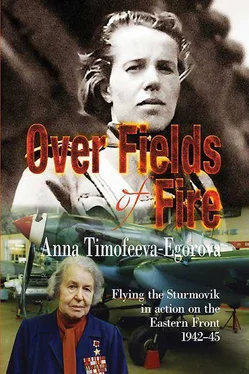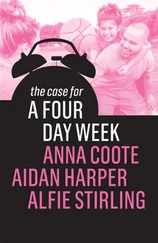“So”, at last the comesk delivered without pulling the pipe out of his mouth, “whichever of you masters the Sturmovik faster and better, learns to bomb and shoot accurately and keep in good formation will be taken on by me as wingman for the very first combat sortie…”
To become wingman to an experienced leader — what else could we dream of? A good leader knows how to assemble the planes that took off after him into a group, how to lead it precisely along the established route and close in on a target which is not that easy to locate on ground pitted by bombs and shells. He knows how to cunningly avoid the ack-ack guns and screens of enemy fighters, and to strike as the situation dictates. It was no accident that the Hitlerites tried hard to shoot down the leader first of all — both from the ground and from the air. If they shot him down the formation would scatter and there would be neither accurate bombing nor well-aimed shooting — and in fact the combat mission would not be carried out.
In order to learn the craft of a flight leader one had to have been a wingman and to have survived. A wingman repeated his leader’s movements during the first combat sorties. He had to keep in formation, and he had no time at all to glance at the dashboard, to notice Messers, to see flak shell bursts. He had no time even to orient himself and often he didn’t even know where he was flying to. Most of the Sturmovik pilots who died, died in their first ten sorties.
Valentin Vakhramov was mastering the Sturmovik quickly and easily and we stubbornly competed with him: who of us after all would be the comesk’s wingman? But once… Vakhramov had flown back from the firing range, landed the plane confidently and already on his run-in, accidentally confusing the levers, he retracted the undercarriage… The Il’s undercarriage immediately folded back and the plane began to crawl on its belly… When we ran up Valentine was already climbing out of the cockpit, gloomily looking at the prop blades bent into ‘ram’s horns’. There were tears in his eyes. No one was scolding him then, nobody was reprimanding him, but he was suffering so badly that it was sad to look at him.
By nature Valentin was a reserved, outwardly rather a coarse man. But this put-on roughness originated from his desire to look more adult. There was nothing funny or mysterious in him but for some reason the pilots had nicknamed him ‘the Fakir’. Just once, forgetting about his ‘dignity of seniority’, he had shown us tricks with cards and burning matchsticks — and the nickname had stuck to him! I knew Valentin was fond of poetry and wrote verses himself, not daring to show them to anyone. I also knew that his mum — a worker on a military production-plant — and a sister he loved tenderly, lived in Siberia. When he got letters from them he would go off somewhere well away where no-one would bother him, and read them several times. Once he had showed me photographs of his family. Eyes similar to his looked at me from them with sadness.
“You have a beautiful sister”, I remarked once.
“Yes”, Valentin agreed, “but she’s badly ill. I doubt whether I’ll see her again. And my mum too — tuberculosis…” Only then I understood from where the Vakhramov’s inescapable sadness came from…
Travel orders to pick up new planes arrived unexpectedly. We thought it wouldn’t hurt if we trained some more over the firing range and in formation as well, but the commanders knew better. And now we were on our way from Baku to Krasnovodsk across the Caspian Sea. From there we would have to make our way to the Volga Region by train via Ashkhabad, Mary and Tashkent.
The Caspian Sea raged so, that it made all the airmen seasick, that was why we got off the ship in Krasnovodsk pale, worn out, and staggering. “Well, ‘Stalin’s falcons’ 103 103 Translator’s note — a common epithet for the Soviet airmen adopted by USSR propaganda bodies during WWII.
, why are you in the dumps? It’s not the ocean of the air!” one of us joked bitterly.
We reached the train station with difficulty, took seats in the wagons and the train carried us to the rear across the Kazakhstan steppes. The train moved so slowly that one could easily walk next to it without falling behind. Having recovered from the sea voyage we felt much more confident and calmer than at sea. Some read, some played dominos, and song lovers gathered around Zhenya Berdnikov, an aerial gunner — Zhenya was a good guitar-player.
During stopovers we would run out to buy milk. It seemed to Vakhramov that a half-litre can, with which a woman was ladling out milk from her bucket, was too dirty, and he was outraged: “How can you dip a dirty can into the common bucket?”
The farmer’s wife silently lifted her skirt, wiped the can with the hem, and smiling sweetly measured out three times half a litre into Valentin’s mess-tin. Valya paid for the milk and with curses handed it over to someone in the queue. Everyone there burst into loud laughter…
Training started on the third day of our trip. The head of the aerial-gunnery service Captain Koshkin was the first to come to our wagon. “We’ll be talking today about targeted shooting and bombing from a Sturmovik ,” he proposed and pulled out the manual from his map-case. “We need to practise it and pass a test.”
“Why a test?” Rzhevskiy asked. “Let’s sign on the brochure that we’ve read it — that’s all the labour we need for such a thing.”
The special instruction on the use of factory markers and viewfinder pins necessary for correct determination of the plane’s diving lead during bombing indeed deserved attention. In order to shoot there was a crosswire gun-sight on the plane: once you’d led the plane close enough to the ground, you pulled the triggers. The cannon, machine-gun and missile tracers might be corrected by one movement of the rudders, and the target would be knocked out. But there was no bomb-sight. Each flyer had worked out his own method of bomb delivery. We’d been bombing as if by eye — using a ‘template’ of ‘bast shoe’ or ‘flying boot’ size. Jokers suggested the following ‘models’: ‘bomb-sight B-43’ for a bast shoe size 43, or ‘F-43’ for a flying boot size 43. “And Egorova will have her own bomb-sight: BF-38 — box calf flying boot size 38!” the pilots laughed.
“Joking apart, how to handle it in reality?” I unwillingly wondered. Well, you could go into a dive using the mark on a wing, but then you had to determine the angle by eye and begin to count seconds: “twenty one, twenty two, twenty three”… At the same time you were not supposed to miss the right altitude — you had to watch the altimeter. But then you were under ack-ack fire, and on top of that you couldn’t break away from your formation — then you would become easy prey for fighters. Generally speaking, although the instruction was just a nuisance to us, we practised it and passed that test before the captain. I have to admit that later our squadron bombed rather well. Either that instruction had helped or we all had the same size of flying boots…
We stayed three days in Mary. Fortunately the news from the front was cheering — our advance in the Stalingrad area had begun. We found out during one of the numerous stopovers that the encircled German troops were in an exceptionally bad situation. They were being systematically bombed by our air force, harassed by the infantry and shelled by the artillery. However, our journey wasn’t without its ‘extraordinary incidents’. In the area we were traveling through were many evacuated families of our regimental comrades. Some had left Derbent earlier so they could catch up with us after seeing their families. One of those who caught up with us reported directly to the commanding officer: “Arrest me, Comrade Lieutenant-Colonel, I’ve killed a man…”
Читать дальше












